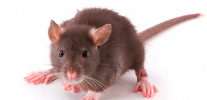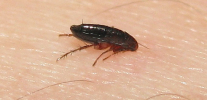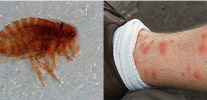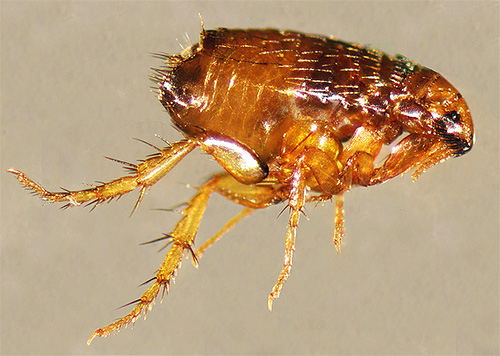
Accidentally detecting on the legs flea bitesToday, few people think about whether fleas are dangerous for humans in general. It would seem that such a tiny creature, barely a few millimeters long, can it really harm its bite, which looks like a needle prick? Therefore, the majority of those bitten simply rubs their red dots with annoyance and soon forgets about the event.
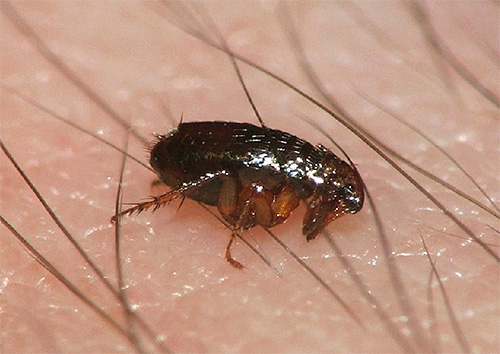
Meanwhile, fleas are dangerous for humans, and physicians and parasitologists consider them to be perhaps the most dangerous ectoparasites in general. Why? Let's understand ...
On a note
Ectoparasites are parasites that attack and harm a person outside, on the skin, hair, in general - parasites on the outer shells of the body. In addition to fleas, for example, bugs, lice, ticks, mosquitoes and flies are also included.
In contrast to them, endoparasites are parasites that live inside our body - helminths, protozoa, less often - the larvae of some insects.
Flea bites, their signs, effects and body reactions
First of all, fleas are harmful to humans because their bites cause a sharp reaction from the body. Of course, one or two bites can turn out to be imperceptible, but with a large number or regular attacks, the body responds to them, and sometimes very violently, namely:
- rashes at bite sites
- swollen lymph nodes
- allergic reaction up to severe edema and fever.
And this is despite the fact that the bites themselves are very itchy, itchy and can hurt. When scratching, additional damage to the affected areas is possible, an infection can enter the blood, resulting in small red spots that fester, causing local inflammation. In severely neglected conditions, for example, in vagrants, such pustular inflammations can develop into ulcers and pyoderma.

Flea bites are painful on their own - these parasites do not produce an enzyme at all ages that is responsible for the anesthesia of the victim and masking the bites. Therefore, some fleas bite very painfully, from which children are particularly affected, which insects do not allow to sleep.


By such anxiety and even the development of a phobia, fleas are harmful to humans when they are not regularly met.
But when living in a room that is heavily infected with fleas, a person is subjected to bites regularly, daily. As practice shows, in this case, in response to constant irritation of the skin in the places of bites, people often develop neuralgia and even nervous disorders.
Feedback
“During a trip to Corsica for several nights we spent the night at the hospitable owner of a fishing boat, from which my husband actually ordered fishing excursions. The place is delightful - overlooking the sea, in an olive grove, an old house, probably also of the Victorian era, with wooden shutters. Every morning - sea bass and homemade cheese for breakfast. You sit on the veranda, scratch flea bites and realize that life is good. Only here the child suffered there - the fleas bit him especially hard, in the daytime he couldn’t even fall asleep from them, he had to put him to sleep outside. Therefore, we left there three days earlier, and at a small point from the bites, we passed only on the day of departure to our historic homeland ... ”
Tatiana, Samara
But the above troubles are only the lesser of the evils that fleas can cause. Fleas are really dangerous because they suffer the most serious infectious diseases of humans.
Flea-borne diseases
Fleas are known primarily for being carriers of deadly human diseases:
- plague, including bubonic
- encephalitis
- anthrax
- trypanosomiasis
- tularemia
- typhus and typhus
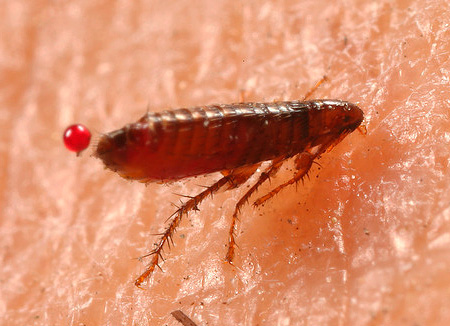
... as well as many other infections, which are also extremely unpleasant - listeriosis, fungal diseases, salmonellosis.
Of course, the likelihood that an accidental flea will be the carrier of a specific causative agent of a fatal disease is small, but nevertheless it is always potentially available. And this is the biggest danger of fleas to humans.
It is interesting
It is fleas, in particular - the southern rat flea - In the Middle Ages they became the cause of one of the deadliest pandemics in the history of mankind - the pandemic of bubonic plague. Then the disease claimed more than 15 million lives. She came first to the Crimea on Chinese ships - with fleas in the fur of gray rats. And already from the Crimea began its march across the continent. Today in Kazakhstan and Central Asia, the causative agent of bubonic plague continues to thrive in the colonies of gophers and burrows of jerboa infected with the same rat fleas.

For humans, not only the fleas that are found in rats are dangerous.Due to the fact that these parasites are not particularly picky about the host species, they can attack other animal species.
For example, if a cat catches a rat, the fleas will easily move from the latter to the purring pet and from there to the house where they will bite the person. Therefore, fleas in a cat are as dangerous as fleas in rats, dogs or rabbits.
And finally, fleas are active carriers of helminth eggs (worms), with a huge number of their species. These fleas also pose a danger to humans.
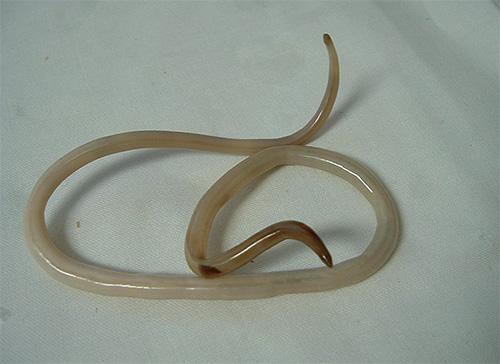
If you accidentally or specifically crush a flea, and after eating food, without washing your hands, you can easily bring eggs of tsepny, flukes, ascaris and other worms into the body. Moreover, the probability of infection with helminths in the attack of fleas is orders of magnitude higher than the probability of obtaining pathogens of infectious diseases.
Why are fleas dangerous for children?
For children, fleas are even more dangerous than for adults. Children more acutely react to the bites of parasites, they are much more likely to have allergic reactions. In this case, the allergy itself after mass bites leads to more serious consequences, rashes and edemas, generalized symptoms such as migraine and swollen lymph nodes are more common.
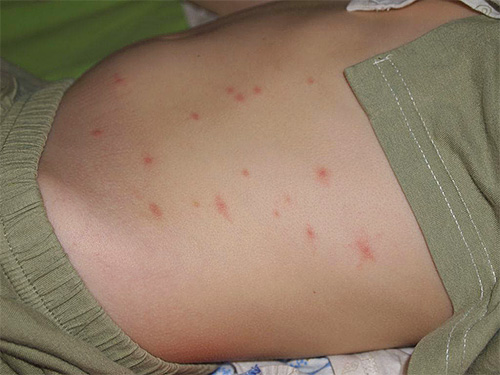
Fleas are especially dangerous for children who have not yet received vaccination.It is they who are at risk of contracting certain infections that standard vaccines protect against.
For pregnant women, fleas are as dangerous as they are dangerous to other people. But it should be remembered that frivolous at first glance, malaise up to the banal allergy can affect the condition of the fetus, especially in the early stages of pregnancy.
Therefore, expectant mothers are absolutely undesirable to encounter parasites anywhere.
Fleas in exotic countries: double danger
Exotic fleas are an exotic danger to humans. So widespread in the Caribbean, Vietnam and India sand fleas they gnaw under nails or just in the skin, stick to the blood vessel and in several days increase in size.
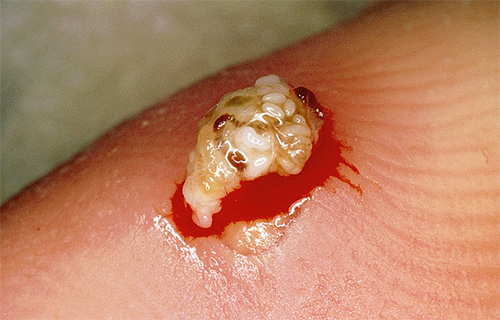
These are females in which their eggs mature. The cavity in which they find themselves with such parasites inflames and causes acute pain to a person. Given that most often they infect the legs, their victims may even temporarily lose the ability to walk.
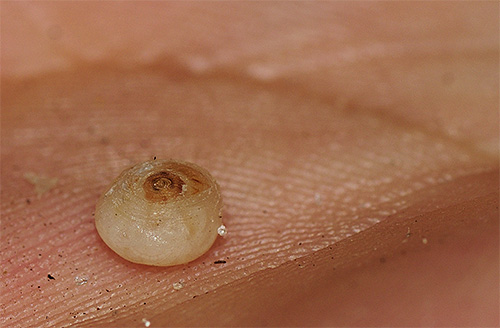
In advanced cases or with mass infection in humans, generalized inflammations can occur and gangrene can develop.
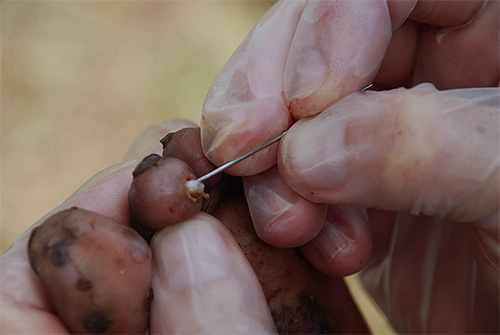
A small percentage of the population in these areas is precisely because of the sandy fleas that it becomes disabled.
What are the most dangerous fleas?
The most dangerous fleas for humans should be considered rat fleas, in particular, the southern rat flea, which most often carries plague. Avian fleas, which are typical sources of the causative agent of salmonellosis, are also dangerous.
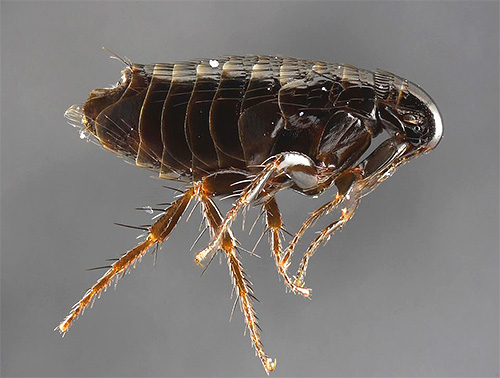
In the tropics, sand fleas are more dangerous, which in themselves can lead to disability, and sometimes - the ability to move.
Interestingly, the largest fleas, parasitizing on cattle, rarely infect humans and almost never are sources of infectious diseases. Therefore, it should be remembered that the most dangerous fleas are small bloodsuckers, often living right next to us - in the basements and holes of rats and mice. They should be feared the most.
Interesting video: fleas in the basement as dangerous sources of all kinds of infections
The life of fleas under a microscope: rare footage

